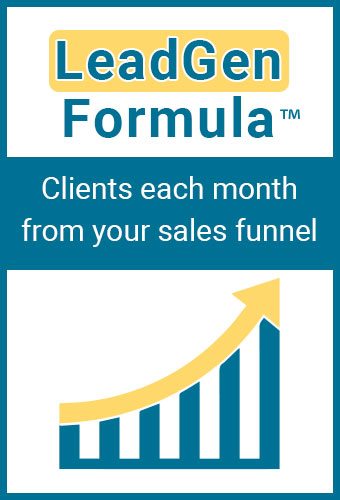In my ten years of experience generating predictable leads for independent financial advisory firms, it’s safe to say that I’ve seen a lot of marketing techniques evolve enormously over that time. One of the biggest ones is also, in a lot of ways, the one that people still don’t understand – email marketing for financial advisors.
I was on the phone with a client just the other day, and we were discussing some of the finer points of his campaign. As we continued to talk, he wanted to know why I was “burying the lede,” so to speak.
“Chris, I don’t get it. This marketing message doesn’t read like a piece of marketing at all. Shouldn’t it basically be like a condensed version of the ‘services’ page on my website? How is this supposed to work if I’m not coming right out and asking for the sale? Are you sure about this?”
The most important thing for you to understand about email marketing, even for financial advisors, is that simply “selling” your products and services is not your primary goal. In an era where people are receiving more email messages on a daily basis than ever, slipping what amounts to a traditional advertisement into someone’s inbox is a sure-fire way to get them to click the “Delete” button as fast as they possibly can.
Instead, you’re going to need to go deeper than you’ve ever gone before. This, of course, requires you to keep a few key things in mind.
1. It’s All About Value
As stated, the number one goal of any modern day email marketing campaign is NOT to just send as many “advertisements” to the email addresses of users as you can every day. There was a time when that was true. But thankfully – mercifully – that day is over.
Instead, you need to think about ways that you can add legitimate value into their lives – even if they haven’t necessarily asked you to do so. If you’ve just written a helpful article about a topic that they care about, consider sending them that as a part of your campaign. Frame your marketing messages in a way that shows you’re looking out for their best interests. Say “I know this is a concern of yours and that you have a lot of questions, so we’ve tried our best to answer them.” At that point, you can include mentions of your services, a call-to-action and other elements in what we call the “Super Signature.”
But if you are not proving value in your email, then people are going to tune you out instinctively – if you were ever able to gain their attention in the first place.
2. The Art of List Segmentation and Generating Higher Open Rates
Gone are the days where email marketing was little more than a volume game. These days, it’s not about sending your marketing message to the largest group of people possible. You instead want to get your eyes in front of a smaller number of ideal prospects within that large list of contacts.
This means that if you’re not already practicing the fine art of list segmentation, now would be an excellent time to start. Break down your email list into a series of smaller, more singularly focused groups. Separate people based on things like asset size, the services you offer, age and other demographic information. This allows you to narrow the focus of your message. Instead of creating an email message that tries to appeal very generally to everyone, you can now create a message that is more specific (and thus more helpful) than ever.
Consider breaking your messaging down into categories based on the type of person you’re talking to, including segments like:
- Young professionals who may be making serious money for the first time in their lives and would like to use it to create a better financial future for themselves and their loved ones.
- Investors and wealth accumulators. In other words, the die hards who are looking for the right partner to help them accomplish their goals in the easiest ways possible.
- Retirement planning. But don’t forget to further segment things here, too, based on people who want to get a head start on retirement (and who may be years or even decades away from that big day) and people who are quickly approaching their early 60s.
- Financial planning. Whether someone is concerned about paying for their child’s college education or just wants to break free from living paycheck to paycheck, it’s always important to capitalize on any opportunity to help.
- Generational wealth transfer. This, too, is a very important issue for many people – showing that you understand WHY that is the case via an email newsletter is a great way to do more than just improve your open rates. It’s a perfect chance to show them WHY you’re the one to provide them the help they need.
3. Personalize, Personalize, Personalize
Along the same lines, you should absolutely practice personalization whenever possible. Truly, this is something you can never do too much – especially as far as your open rates are concerned.
Personalization isn’t just a great way to improve the engagement rates of your email marketing for financial advisors – it’s also a perfect chance to increase your larger return on investment, too. Even something as simple as saying “Dear [INSERT NAME HERE]” instead of the more general “Dear Sir or Madame” can make a big impression in a short amount of time.
You can also go deeper, too. Create specific, smaller sub campaigns targeted at people who already have some type of interaction with your brand. “We know you were just interested in X, so based on that we thought you might be interested in Y and Z, too.” Even emails with personalized subject lines are more likely to be opened than those that read more generic in nature.
Never forget that email marketing is only cold and impersonal if you allow it to be. Every opportunity you have to inject a little personality into the proceedings is one that you should capitalize on – end of story.
4. The Dangers of Operating Without a Plan
A lot of people make the mistake of assuming that because email marketing is “easier” to create than other types of collateral, you can get a way with a bit of a looser approach when it comes to your strategy. Sure, you spend huge amounts of time each week planning out blog posts, white papers and other types of collateral weeks or even months ahead of time. Why bother with a plan for email when you’re just typing out a few quick messages, right?
Wrong.
In truth, the success of your email marketing for financial advisors campaign depends on your ability to plan things out as much as possible. Remember that in the end, what you’re trying to do is guide someone down the sales funnel in the most efficient way possible for all involved. To do that, you need to understand how someone’s needs and wants change and evolve as they move from one end of the funnel to the other.
That’s ultimately what your plan is all about. Every time someone reaches a new way point on their customer journey, you should have an email message lined up ready to acknowledge that and take them to the next step. You can’t get to that point if you’re still insisting on “making things up as you go along,” so to speak.
We have a handy chart of our monthly email marketing strategy that shows how we execute three different types of email campaigns; if you would like a copy of it, just reach out to us.
5. The Importance of Continuity
Likewise, one thing you’ll want to consider involves putting just a single person in charge of email replies; this is especially true of the “9 Word Email.” When it comes to creating those messages, everyone can certainly help. But as the responses start rolling in, having a single person in charge of carrying things further brings with it a number of unique benefits that are hard to ignore.
For starters, every reply will feel like it’s coming from the exact same place – because it is. There will be a commonality in the language being used, and the shape that conversations begin to take. This helps to immediately create a better, more reliable experience from customers who are starting to show interest in what you have to say. It also helps to avoid brand confusion. If people get one experience when replying to an email and another when visiting your website and another when picking up the phone and making a call, they’re going to start to get confused about what your business actually does and who is driving that proverbial ship.
Taking the time to create a more consistent experience will let people get an impression of the types of interactions they’re likely to have with your brand as things get more serious. If they like you in these early days, they’ll really like you once they start to learn more about the services that you have to offer.
At Midstream Marketing, we’ve always believed in the idea that you can only make one first impression. We’ve constructed our own LeadGenFormulaTM to not only acknowledge this, but to help you take advantage of it. Yes, some people are going to have that first impression via a phone call or an in-person interaction. But for the people who communicate with your brand for the first time via an email, tips like these will make sure they have the most pleasurable and valuable experience possible so that YOU can then get to work taking them to the next level on your own terms.
If you’d like to find out more information about the best email marketing tips for financial advisors, or if you have any additional questions you’d like to discuss in a bit more detail, please don’t delay – contact Midstream Marketing today.



